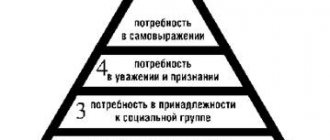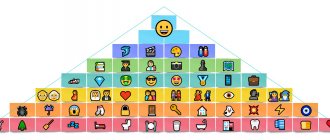What are needs?
Need is an internal feeling of need for certain resources, circumstances or actions. Of the entire animal world, humans have the widest range of needs: from mundane physiological to sublime spiritual. Needs include all material and intangible resources, actions, circumstances and other factors necessary for a person to feel satisfied or happy.
Human needs
appear as follows:
- An unmet need is usually associated with a feeling of discomfort, anxiety, melancholy and other negative emotions.
- Satisfaction of a need is accompanied by positive emotions (both directly at the moment of its satisfaction, and when realizing that it has already been satisfied).
- There is a fixation on the subject of need. A person’s attention involuntarily concentrates on what he lacks. When we get hungry, we begin to more sensitively detect appetizing smells, and a lonely person in any circumstances looks for reasons to meet a potential “soul mate.”
Also, human needs are characterized by the following features:
- people need much more to achieve a state of satisfaction than other species;
- with age, the number of needs increases, their priorities change (a child needs much less to be happy than an adult, and for older people social and spiritual values become much more important);
- there is a completely unambiguous hierarchy of needs, and those that are of great importance can “drown out” the less important ones.
Needs are the most important motivator that forces us to act and move forward. The most basic of them force us to work to ensure our existence, and the higher ones stimulate us to development, improvement and self-actualization. All existing achievements of mankind, including inventions, scientific theories, objects of art, musical and literary works, were created under the influence of human needs.
Sociological and psychological approaches to the concept of needs
There is a scientific tradition of studying needs in sociology and psychology, although this topic, as a rule, has not been deeply developed. As a rule, the most famous and successful concepts of needs are the American psychologist Abraham Maslow, the Polish psychologist Obukhovsky, and others.
We would like to reiterate that there is no single classification of needs. Psychologists were even forced to abandon their complete list, since human needs are very numerous and constantly changing, arising and disappearing. However, there are several classifications that help organize our knowledge about human needs.
Psychologists usually divide into primary or essential needs, without the satisfaction of which a person cannot exist, and secondary, non-essential, the satisfaction of which is not a prerequisite for a person’s physical existence.
In origin, needs can be natural and cultural.
Classification of human needs
In psychology, all human needs are usually divided into three groups. This classification is quite unambiguous, since each group has very specific and obvious criteria. Let's look at each of them in detail.
Biological needs
This category includes basic needs aimed at survival, achieving physical comfort and procreation. It includes:
- delicious food (taste is important to determine freshness and nutritional value);
- clean water to quench thirst;
- comfortable living conditions;
- security and confidence in your future;
- satisfaction of sexual needs.
The listed aspirations are present in all living beings. They were formed evolutionarily to ensure the survival of the population. Essentially, they are all mechanisms that allow a person (or other creature) to survive and achieve “reproductive success” (produce offspring and ensure their survival in the future).
Social needs
Since man is a social being, he has a number of instinctive aspirations aimed at increasing his own importance in society or his group. The most illustrative examples are:
- Self-identification.
A person associates himself with his social group, while striving to recognize himself as an individual with special personal and other qualities. - Self-affirmation.
It is important for any person to be proud of their own actions and achievements, as well as to feel respect from others. - Altruism and passionarity.
Most of us derive pleasure from doing things that benefit other people or society as a whole. At the same time, self-esteem grows even if our contribution goes unnoticed by others, since for an altruist the act itself is important, and not the approval of others.
Spiritual Needs
There is a system of universal spiritual values that most people share in one way or another. We strive for moral and spiritual growth, appreciate beauty, grace of form and harmony, enjoy contemplating objects of art and listening to beautiful music. At the same time, each person has his own taste, so we all like different styles in music and styles in painting. In addition, priorities of spiritual values change throughout life.
Spiritual needs include:
- Self-actualization.
Obtaining new knowledge, expanding the range of interests and hobbies, professional growth, advanced training - these are all natural aspirations for a person who is currently not concerned with satisfying basic biological needs. - Self improvement.
As we grow up, we understand that we like to become better not in order to please someone, but simply to feel our progress. We give up smoking and alcohol, take up sports, begin to maintain a daily routine and control our stress levels. We just like to think that we're getting a little better every day. - Romantic love.
This point could be considered a manifestation of the reproductive instinct, but for us it is something much more. It is very important for us to have a loved one nearby who inspires us and gives us not only sexual but also emotional pleasure.
Spiritual needs, unlike biological and social ones, are present only in humans. Moreover, their list is not just extensive, but almost endless, since each person finds some of his own hobbies that do not have to be shared with someone else. Some people like fishing, some prefer knitting, some watch TV series, some reread The Little Prince for the hundredth time, some adore the sound of pouring rain outside the window, and some experience peace from the echoing the croaking of frogs in a nearby pond.
Maslow's Extended Pyramid
In later works, the pyramid was supplemented with two levels, located between prestige and spirituality:
- cognitive needs: knowledge, skills, desire for research, creation. There is a desire to learn, gain new knowledge and expand the range of hobbies;
- aesthetic needs: beauty, harmony, order. A person feels a desire to travel, visit exhibitions and museums, develop culturally, enjoy the beauty of nature and peace of mind.
Abraham Maslow developed only the theory of needs; it was put into table form by other scientists (about 15-20 years after the publication of the scientific works of the American psychologist). Over the years, the pyramid has not lost its relevance; today it is used by analysts, marketers and other sales representatives who seek to better understand potential buyers.
Maslow's Extended Pyramid
Scientific theories about human needs
Abraham Maslow's theory
This is the most famous classification of human needs, everyone who has at least once been interested in self-development knows about it. This concept was proposed and developed by the American psychologist Abraham Maslow in a number of his works on motivation. He sorted all human needs by elevation: from lower (biological) to higher (spiritual). Due to the characteristic form of the schematic image, this classification was called “Maslow’s Pyramid”.
The author himself identified 5 levels in his classification:
1. Physiological needs.
In this group he included food, water, sleep, sexual satisfaction - all the basic needs of our body.
2. Safety.
When all physiological needs are satisfied, a person seeks to protect himself and his family. This group includes not only good protection from predators and other dangers, but also confidence in stability and order.
3. Love and belonging.
Here we are talking about good relationships, love, friendship, belonging to a certain social group.
4. Respect and recognition.
If a person is confident in his own well-being in all areas included in the first three levels of the pyramid, he has a strong need for respect and recognition. Here we are not talking about the banal “You respect me, no?!”, but about real respect for actions and achievements.
5. Self-actualization.
Abraham Maslow included in this group self-development, self-education and other ways of working on oneself, one’s skills, knowledge and abilities.
If you look closely at the 5 tiers of Maslow’s pyramid, you will notice that the first two are biological, the third and fourth are social and partially spiritual, and the fifth are purely spiritual needs.
One of the most important statements of Maslow's theory is that each level becomes important only if all the needs located at lower levels are fully satisfied. For example, hunger or unfulfilled sexual instinct (first level) makes a person forget about caution and safety (second level).
If we compare lower needs with higher ones, we can notice several characteristic differences:
- higher needs appear much later (they first appear in adolescence, after which they develop throughout life);
- higher needs are perceived by most people as less important, “optional”;
- the higher the need is in the hierarchy, the easier it is to postpone its implementation to the future in order to solve more pressing problems;
- people living at higher levels of Maslow's pyramid tend to have good health (partly because they take care of it), experience less stress and sleep better;
- a person receives much more joy and pleasure from satisfying higher needs.
The original concept proposed by Abraham Maslow had 5 tiers, which we discussed above. Later, many authors took liberties in its interpretation and introduced additions, increasing the number of levels. Therefore, do not be surprised if you see different variations of the pyramid with 7 or 10 tiers. In any case, the basic concept of Maslow's theory remains.
Read more about Maslow's Pyramid of Needs in this article.
Alderfer's ERG theory
American professor Clayton Alderfer proposed an alternative theory of motivation. It does not contradict Maslow’s theory, but it uses its own classification of needs, which includes 3 groups (the abbreviation ERG is derived from their names):
- Existence (existence, life).
- Relatedness (relationships, communication).
- Growth (personal growth, development).
As you might guess, the first group is represented by physiological needs, the second by social, and the third by spiritual. At the same time, Clayton Alderfer showed that the relationship between these groups is somewhat more complex than Maslow described (priorities are influenced not only by the fact of satisfaction itself, but also by the degree of satisfaction).
In addition, he noticed that dissatisfaction with higher needs increases the desire to satisfy lower ones. For example, it is known that during any crisis the revenue of confectionery stores increases sharply. This is explained by the fact that people, losing a sense of stability, begin to buy more sweets (even those who do not like them at all and usually do not buy them).
Fromm's theory
German psychologist and sociologist Erich Fromm considered social interaction to be a key factor influencing the human psyche. This was reflected in his theory of needs. He proposed a five-point hierarchical scheme:
- Interpersonal connections (love, friendship).
- Creativity (any creative activity, regardless of type).
- Feeling of strong and deep roots (stability).
- Search for the ideal and assimilation to it (self-improvement).
- Knowledge of the world (spiritual improvement).
As one of the founders of neo-Freudianism, Fromm believed that our basic needs are controlled by the unconscious. But since the unconscious often encounters such obstacles as taboos, stereotypes, logic, rationality, etc., needs remain unfulfilled.
McClelland's theory of acquired needs
American writer and psychologist David McClelland proposed his theory of motivation. He believed that all needs are formed in childhood. At the same time, he divided them into three groups, explaining the mechanism of formation of each of them:
- Involvement.
This need arises in children who were engaged in collective activities and played team games. As a result, even in adulthood, they feel the need to be part of a group, to participate in a socially significant project or movement. - Power.
If in childhood one way or another is encouraged to control other children, in adulthood such a person needs a sense of power. Also, this need can be formed under the influence of the family atmosphere. - Success.
If a child is taught to be independent, to achieve something, to receive prizes and certificates, as an adult he will also need success.
Principles of Maslow's pyramid
Psychologist Abraham Maslow, who worked in the USA in the 20th century, argued that human needs have a hierarchical structure and depend on each other: the satisfaction of each of them entails an increase in ambitions and the emergence of new interests. For example, a person’s financial capabilities do not allow them to meet basic needs: food, their own housing, security. At this stage, a person is worried about survival, he has neither the strength nor the capabilities for further development. Having achieved a stable income and bought their own home, a person begins to think about traveling, starting a family and purchasing courses to improve professional skills.
The more needs are covered, the higher and freer the aspirations and possibilities. To move to a new level, a person needs to close the needs related to the previous one, but variations are possible here. Maslow emphasized that the principle of distribution of needs may depend on the psychological type of a person. In the value system of an active careerist, family will occupy the last place, and for a creative person, spiritual development is more important than position in society. Some people are not interested in developing higher needs, being content with little, but such changes occur as a result of unfavorable living conditions or under the influence of aggressive external factors.
How to determine client needs using Maslow's pyramid
The following tools are used to determine client needs:
- drawing up a client portrait using Sherrington’s 5W method. The marketer collects information about who the client is, what exactly the business offers, where and under what conditions they will buy this product;
- analysis of consumer interests. An analysis of reactions to different advertising messages is carried out, a map of the client’s journey and click dynamics are studied;
- surveys to identify pain points, budget, needs, age and other individual characteristics of customers from different segments.
Surveys can be conducted on social networks, in a playful way through quizzes, or using Google Forms.
You can ask the client about his needs and expectations directly ; a good solution would be to collect information about the experience of using a similar product and shopping in other online stores. The collected data is systematized, after which the target audience is segmented and campaigns are developed that meet the expectations and interests of each group.
How to Use Maslow's Needs Theory in Marketing
Development of commercial and unique selling propositions
Having identified the client's needs, the business will be able to speak the same language with him. For example, an online store delivers ready-made food. The store's customers are people who want to quickly satisfy their hunger after a hard day at work or returning from a business trip. They are not ready to wait for a long time, so the advertising campaign is based on the slogans “We will deliver in 30 minutes”, “Get your order for free if it is not delivered within 1 hour”, “A quick snack like grandma’s” and others. It makes no sense to offer gourmet delicacies to a person who plans to quickly eat pizza while in the middle of a traffic jam.
Clients of online stores selling expensive jewelry or watches gravitate towards elements of prestige. Because of this, marketing campaigns for high-budget products use the words “unique,” “premium,” and “limited editions.” After determining the client’s place in the pyramid, you can develop proposals that will work effectively here and now, reflecting the specifics of the business and leveling objections.
Adaptation to changing customer requirements
The needs of potential buyers are changing, due to the growth of sales markets and the introduction of new services. Over the past 10 years, messenger marketing, door-to-door delivery, augmented reality applications, and online tools on websites that allow you to calculate prices or select clothing sizes have gained popularity. If an online store cannot offer in-demand services, then customers will go to competitors. The formation of new proposals is carried out on the basis of needs analysis.
Gaining loyalty
Elements of Maslow's pyramid are often integrated into loyalty marketing strategies. They are based on three basic principles that have similar features to the theory of needs:
- at the first level, the client goes through transactional loyalty: he chooses a product, service or services, receiving benefits. The customer spends money, but at the same time, physiological needs are met and a feeling of security is formed, consonant with confidence in the seller;
- By moving to the second level of the program, the client receives recognition. The online store has a comprehensive amount of information about the buyer, and he receives more benefits, which is an incentive to increase loyalty. The client develops a feeling of mutual respect and social belonging;
- working with customer experience. The online store satisfies the client’s obvious and hidden needs, for which he makes purchases and returns to the seller again. The buyer feels important, he is ready to work for the benefit of the company, so he starts active word of mouth.
By guiding the client through all stages, the marketer has the opportunity not only to start the sales process, but also to acquire a loyal customer who will willingly advertise the brand or company. Based on this data, loyalty programs, referral programs and sales funnels, as well as advertising campaigns (contextual, social networks, etc.) are formed.









